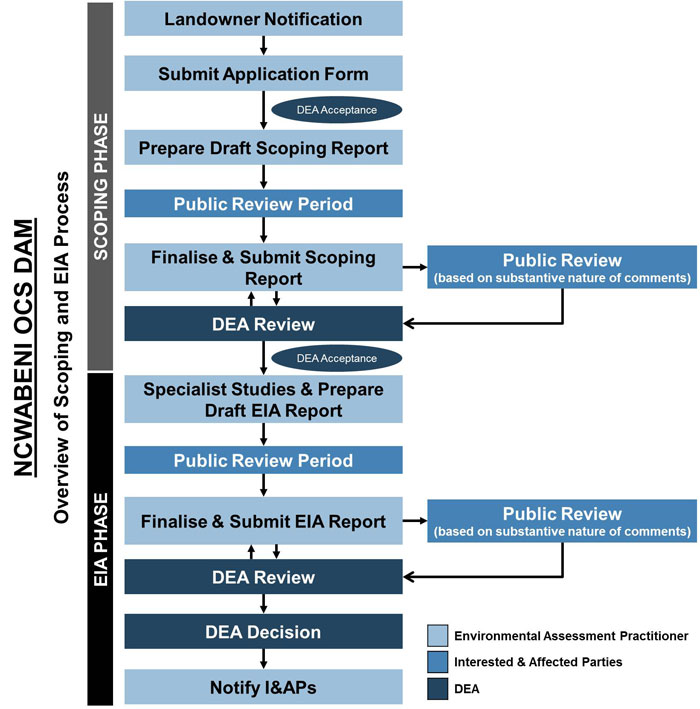EIA Process
The proposed Ncwabeni OCS Dam triggers activities listed in terms of Government
Notice (GN) No. R544, R545 and R546 of 18 June 2010, and thus requires
authorisation in terms of the Environmental Impact Assessment (EIA) Regulations
(2010), promulgated under the National Environmental Management Act (No. 107 of
1998). DWS is the applicant for the proposed Ncwabeni OCS Dam and the EIA
competent authority is the National Department of Environmental Affairs (DEA).
Nemai Consulting was appointed DWS to act as the independent Environmental
Assessment Practitioner to undertake the requisite environmental assessment for
the proposed Ncwabeni OCS Dam.
Note that a separate EIA will be conducted for the upgrade of the abstraction
works, where the Ugu District Municipality will act as the applicant and the EIA
competent authority will be the KZN Department of Agriculture, Environmental
Affairs and Rural Development (DAEARD).
An overview of the Scoping and EIA process for the Ncwabeni OCS Dam is provided
below.

The review of the final Scoping and EIA Reports will be based on the substantive
nature of comments received on the draft documents.
Borrow Areas
Borrow areas will need to be created to source material for construction
purposes. Under section 106(1) of the Minerals and Petroleum Resources
Development Act (Act No. 28 of 2002) (MPRDA), DWS is exempt from the provisions
of sections 16, 20, 22 and 27 "in respect of any activity to remove any mineral
for road construction, building of dams or other purpose which may be identified
in such notice”.
In terms of Section 106(3) of the MPRDA, DWS does not need to prepare an
Environmental Management Programme (EMP) for a borrow area that is located on
Government Water Works (GWW). Although exempted, DWS must still submit EMPs for
all borrow areas situated outside of the GWW for approval by the Department of
Mineral Resources (DMR), in terms of Section 106(2) of the MPRDA.
Specialist Studies
The nature and extent of the specialist studies to be conducted for the purposes
of the EIA will be determined during the Scoping Phase. At this stage, the
following specialist studies have been identified:
Fauna and Flora Study; Heritage Impact Assessment; Aquatic and Riverine Assessment; Ichthyological Study; Agricultural Impact Assessment; Visual Impact Assessment; Impact Statement on Downstream Estuary; Rehabilitation Study; Wetland Assessment and Delineation Study; Economic Study; and Social Impact Assessment.
Additional studies may be identified as the EIA process unfolds.
How can you become involved?
The Public Participation Process (PPP) for the proposed Ncwabeni OCS Dam entails
the following:
Developing a database of Interested and Affected Parties (I&APs), including landowners, authorities, formal agricultural sector, key stakeholders, interest groups and the general public (amongst others); Notifying I&APs through the placement of notice boards and newspaper advertisements (local and regional newspapers), and also distributing Background Information Documents; Convening public meetings (dates to be confirmed) to allow for project-related discussions and to provide an overview of the EIA findings; Granting I&APs the opportunity to review the Scoping and EIA Reports (to be completed later on in process); and Advertising the environmental decision in the local newspaper and notifying all registered I&APs of the decision and appeal process.
I&APs are encouraged to participate in the process in order for concerns to be
addressed and included in the environmental assessment reports.

|